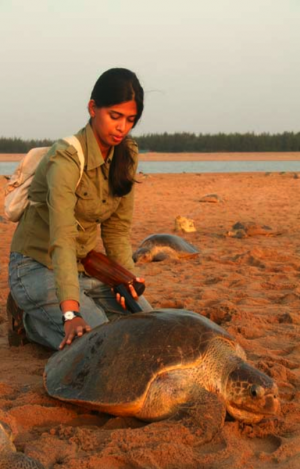Lighting the way to less disoriented turtle hatchlings
Night falls on the desolate beach of an uninhabited island, and deep within the sands begins the scramble of a baby sea turtles’ race for life. From the moment it can crack open the shell and make it to the surface of the sand, it has to keep moving as fast as it can to avoid being eaten, desiccated by the rising sun or wasting its limited yolk reserves. It makes its way to the sea, by avoiding the deep, long shadows of hills and trees on land, and tracking the bright reflections of the moon and stars on the water. However, most hatchling (baby) sea turtles are not as lucky. Coastal development has caused a great deal of death on beaches, since many hatchlings move landwards and die as road-kills or from sheer exhaustion, having been misguided by artificial electric lighting.
The bright future of light pollution
The olive ridley sea turtle (Lepidochelys olivacea) that nests along most of the Indian coastline is awarded the highest protection status (Schedule I of the WPA, 1972) by law. However, a number of development projects are currently being sanctioned particularly in coastal Orissa where this species of turtle lays more than a million eggs every year. This could mean more than a million hatchlings all moving in the wrong direction i.e. away from the sea and ultimately being killed. Although Environmental Impact Assessments (EIAs) are required by law for such proposed projects, none so far have considered the impact of light pollution on sea turtle populations. This threat has never been studied in India and nor have solutions been sought.
Research on responses and solutions
For her master’s dissertation project Divya Karnad studied the effects of different wavelengths and intensities of light on the orientation of olive ridley sea turtle hatchlings. She found that the best solution to reduce the number of hatchlings misguided landwards is to use longer wavelength (in the orange-red regions of the spectrum) and lower intensity light. She also looked at how existing beachfront light impacted hatchlings on a mass nesting beach (Rushikulya, where about a hundred thousand turtles nest during the season annually) in Orissa.
Hatchlings seemed to respond to a bright horizon irrespective of whether they could actually see the source of light or not. Therefore, even lights at a considerable distance from the beach could still have an impact on hatchlings on the beach. The only solution was to have light barriers, either as natural sand dunes or plantations. Further, barriers at the source of light could greatly reduce the amount of spillover onto the beach.
Recommendations to authorities and individuals
A combination management plan, where the types of bulbs used, as well as light barriers and other light cutting measures such as restoring sand dunes and other natural beach vegetation that would serve as cues for hatchlings to re-orient themselves towards the sea, is recommended to help sea turtle hatchlings continue unaffected in their race for life. Although it is up to the authorities to enforce such procedures on large development projects and the like, individuals who have beach front property could also make a difference by following such simple procedures as using curtains or blinds to prevent light spillage from their homes.
International interest and recognition
This work was selected for the Student Conference on Conservation Science, held at the University of Cambridge in March 2009. The bursary scheme, along with partial travel support from NCBS, enabled her to attend the conference. The conference had attendees from 68 countries, representing both the developing and the developed world. The variety of presentations, both oral and as posters was astounding. There were sessions devoted to African conservation, Marine issues, Aquatic and coastal issues etc. Particularly noteworthy were talks on the impact of war on biodiversity in Sierra Leone, REDD and on the decline of marine fisheries.
Divya’s work was chosen as an oral presentation in the session dedicated to aquatic and coastal issues. Her presentation was scientific, yet eloquent, with simple objectives and solutions. Consequently, it was judged the best presentation of the year. The second place was awarded to Murray Collins, from the Imperial College at London, and the third place to Baruani Mshale from the University of Michigan. Divya has just completed her Master’s in Wildlife Biology and Conservation from the WCS‐Manipal University partnership course conducted at NCBS, Bangalore, India. Her work is also in press, as a paper in the journal Biological Conservation.

Comments
Post new comment